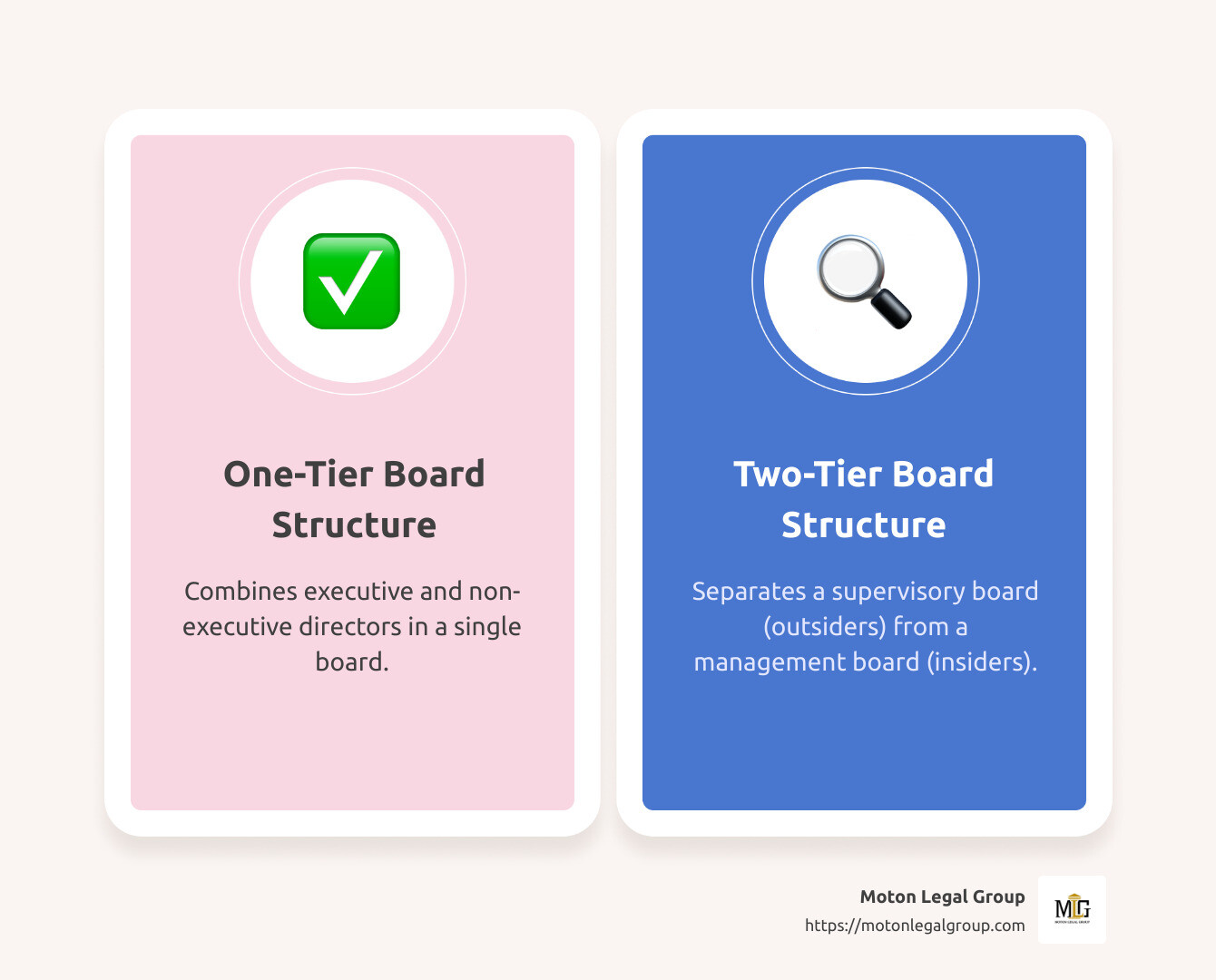Importance of Corporate Governance and Board Structures
When searching for types of board structure in corporate governance, it’s essential to know there are typically one-tier and two-tier board structures. Here’s a quick snapshot:
- One-Tier Board Structure: Combines executive and non-executive directors in a single board.
- Two-Tier Board Structure: Separates a supervisory board (outsiders) from a management board (insiders).
Effective corporate governance is central to the success and ethical operation of any company. It encompasses the systems, principles, and practices by which a company is directed and controlled. A critical element of corporate governance is the board structure, which directly impacts decision-making and the company’s long-term health.
In the field of company governance, a well-structured board ensures accountability, transparency, and strategic oversight. These boards are often tasked with risk management and ensuring that the company’s activities align with shareholder and stakeholder interests. Choosing the right board structure can make or break a company’s ability to steer legal, financial, and ethical problems.
My name is M. Denzell Moton, Esq, and I bring a wealth of experience in types of board structure in corporate governance. With a background in Business Administration and a track record in legal writing and trial programs, I aim to explain these complex concepts for you.

What is Corporate Governance?
Corporate governance is the system of rules, practices, and processes by which a company is directed and controlled. It serves to balance the interests of a company’s many stakeholders, including shareholders, senior management, customers, suppliers, lenders, the government, and the community.
Rules, Practices, and Processes
Rules in corporate governance are the formal regulations and guidelines that dictate how a company should operate. These include laws enacted by governments as well as internal policies set by the company itself.
Practices refer to the standard procedures and behaviors that companies follow to comply with these rules. For instance, a company might have a practice of holding quarterly board meetings to review financial performance.
Processes are the specific steps and methods used to implement rules and practices. This could involve everything from how a company reports its earnings to how it manages risk.
Stakeholders
Stakeholders are individuals or groups who have an interest in the performance and actions of a company. Key stakeholders include:
- Shareholders: Owners of the company who invest capital and expect returns.
- Senior Management: Executives like the CEO and CFO who are responsible for daily operations.
- Customers: Individuals or entities that purchase the company’s products or services.
- Suppliers: Companies that provide goods or services needed for the company’s operations.
- Lenders: Financial institutions or individuals that provide loans to the company.
- Government: Regulatory bodies that enforce laws and regulations.
- Community: The general public and local communities affected by the company’s operations.
Accountability, Transparency, Fairness, and Responsibility
Accountability means that those who manage the company are answerable to the stakeholders. This ensures that decisions are made in the best interest of the company and its stakeholders.
Transparency involves providing clear and accurate information to stakeholders. This could be financial reports, meeting minutes, or strategic plans. Transparency builds trust and helps stakeholders make informed decisions.
Fairness ensures that all stakeholders are treated equally and justly. This means that no single group’s interests should be prioritized over another’s unfairly.
Responsibility involves ethical and prudent management practices. Companies must act responsibly towards their stakeholders and the environment.
Risk Management
Risk management is the process of identifying, assessing, and mitigating risks that could impact the company. This includes financial risks, operational risks, and even reputational risks. Effective risk management helps a company to steer uncertainties and maintain stability.
In summary, corporate governance is about creating a framework that ensures a company operates efficiently, ethically, and in the best interest of all its stakeholders. It involves a blend of rules, practices, and processes that promote accountability, transparency, fairness, and responsibility while managing risks effectively.
Next, let’s dig into the Types of Board Structures in Corporate Governance to understand how different frameworks can shape a company’s governance.
Types of Board Structures in Corporate Governance
When it comes to corporate governance, the structure of a company’s board is crucial. Let’s explore the two main types: one-tier and two-tier board structures.
One-Tier Board Structure
A one-tier board structure, also known as a unitary structure, combines both executive and nonexecutive directors in a single board. This model is common in countries like the United States and the United Kingdom.
- Executive Directors: These are typically company insiders like the CEO and CFO who are involved in the day-to-day operations.
- Nonexecutive Directors: These members are independent and provide oversight without being involved in daily management. Their main role is to ensure that the company is being run in the best interests of the shareholders.
Benefits of One-Tier Boards:
– Unified Decision-Making: Having all directors in one board facilitates quicker decision-making.
– Direct Communication: Executive and nonexecutive directors can easily communicate, reducing delays.
However, the downside is the risk of groupthink and less independent oversight.
Two-Tier Board Structure
In contrast, a two-tier board structure separates governance into two distinct boards: the supervisory board and the management board. This model is prevalent in countries like Germany and the Netherlands.
- Supervisory Board: This board is composed mainly of nonexecutive directors and represents stakeholders, including shareholders and sometimes union representatives. They focus on long-term strategy, reputation, and oversight of the management board.
- Management Board: This board consists of executive directors who handle the day-to-day operations. They manage resources, oversee the workforce, and implement strategies set by the supervisory board.
Benefits of Two-Tier Boards:
– Clear Separation of Roles: This allows each board to focus on its specific responsibilities without overlap.
– Improved Oversight: The supervisory board provides an additional layer of oversight, reducing the risk of poor management decisions.
However, this structure can lead to slower decision-making and potential communication issues between the two boards.
In summary, the choice between a one-tier and two-tier board structure depends on a company’s specific needs and regulatory environment. Each model offers unique advantages and challenges, influencing how effectively a company can govern itself.
Next, let’s explore Common Governance Models to see how these board structures are applied in different contexts.
Common Governance Models
Understanding corporate governance means knowing the different models that guide board structures. Let’s explore some of the most common governance models.
Anglo-American Model
The Anglo-American model, also known as the shareholder model, is prevalent in the United States and the United Kingdom. This model emphasizes the interests of shareholders.
- Board of Directors: The board is primarily responsible for making major decisions. Directors are elected by shareholders and are supposed to act in their best interests.
- Shareholders: They have the right to vote on important issues, including the election of board members.
- Management: Managers, including the CEO and CFO, are accountable to the board and, by extension, to the shareholders.
- Regulatory Support: In the U.S., agencies like the SEC ensure that shareholder rights are protected.
Continental Model
The Continental model, also called the German model, is common in European countries like Germany and the Netherlands. This model uses a two-tier board structure.
- Supervisory Board: This board oversees the management board and is made up of shareholders and employee representatives.
- Management Board: Responsible for day-to-day operations, this board is separate from the supervisory board.
- National Interests: Governments often have a strong influence on corporate governance, aligning company activities with national objectives.
- Stakeholder Engagement: This model values the input of various stakeholders, including employees and the community.
Japanese Model
The Japanese model places a strong emphasis on relationships and loyalty. Key players include banks, affiliated entities, and major shareholders called Keiretsu.
- Banks: Often the largest shareholders, banks play a significant role in decision-making.
- Affiliated Entities and Keiretsu: These groups have trading relationships and can remove directors if profits decline.
- Government: Regulatory policies and government objectives heavily influence corporate activities.
- Corporate Transparency: Due to the concentration of power, transparency can be limited.
Carver Model
Developed by John Carver, the Carver model is a policy board model that works well for both corporations and nonprofits.
- Board of Directors and CEO: The board sets policies, and the CEO manages day-to-day operations.
- High Trust in CEO: The board gives the CEO a high level of trust to run the organization effectively.
- Few Standing Committees: This model minimizes the number of standing committees to streamline governance.
Traditional Model
The Traditional model is the oldest form of corporate governance, often considered outdated.
- Collective Responsibility: The board has collective responsibility for all matters and speaks with one voice.
- Processes and Policies: Outlined in the bylaws, this model focuses on structures rather than outcomes.
Cortex Model
The Cortex model emphasizes the value an organization can bring to the community.
- Board Duties: Focus on clarifying outcomes and establishing performance standards.
- Community Focus: This model is designed to help organizations achieve community-centric goals.
Consensus Model
Also known as the Process model, the Consensus model is a form of the cooperative model used by nonprofits.
- Equal Votes and Responsibilities: All board members have equal votes, responsibilities, and liabilities.
- Best for Small Corporations: This model works well for small organizations without major shareholders.
Competency Model
The Competency model is ideal for newer organizations needing governance expertise.
- Focus on Skill Development: Emphasizes developing the knowledge and skills of board members.
- Communication and Trust: Building relationships and trust is crucial for overall good board performance.
These common governance models show how different board structures can be applied to meet various organizational needs. Each model has its strengths and weaknesses, making it essential to choose the one that aligns best with your company’s goals and regulatory requirements.
Next, we’ll explore the Benefits of Different Board Structures to understand how these models contribute to effective governance.
Benefits of Different Board Structures
Understanding the types of board structure in corporate governance is crucial for recognizing their benefits. Let’s break down how these structures can positively impact a company.
Ethical Practices
Ethical business practices are at the heart of good corporate governance. A well-structured board ensures that ethical guidelines are not just written but practiced. For example, having a diverse board with both insiders and independent members helps bring in various perspectives, making it harder for unethical practices to go unnoticed. This diversity promotes integrity and fairness in decision-making.
Stakeholder Engagement
Different board structures allow for better stakeholder engagement. In the Continental Model, the supervisory board includes not just shareholders but also union representatives and sometimes banks. This ensures that multiple stakeholder interests are considered, leading to more balanced and inclusive decision-making.
Risk Management
Effective risk management is another benefit. Boards play a critical role in identifying and mitigating risks. A two-tier board structure, with separate supervisory and management boards, provides a clear division of responsibilities. This separation allows the supervisory board to focus solely on oversight, ensuring that management’s risk assessments are thorough and unbiased.
Transparency
Transparency in corporate governance builds trust with shareholders and other stakeholders. The Anglo-American Model emphasizes transparency by ensuring that financial performance, conflicts of interest, and risks are communicated clearly and promptly. Regular updates and open communication channels between the board, management, and shareholders foster a culture of transparency.
Accountability
Accountability is essential for maintaining trust and ensuring that the company operates in the best interests of its stakeholders. A well-structured board makes sure that both the board and management are held accountable for their actions. For instance, the board’s responsibility to recruit and hire a CEO ensures that the leadership is aligned with the company’s goals and accountable for its performance.
Strategic Decision-Making
Lastly, different board structures improve strategic decision-making. Boards like the Policy Board focus on setting broad policies and goals, allowing the CEO and senior staff to implement these strategies effectively. This separation of strategy and execution ensures that the company can adapt to changes and make informed, strategic decisions that drive long-term success.
In summary, the types of board structure in corporate governance offer various benefits, from ethical practices to strategic decision-making. Each structure has its unique advantages, making it essential to choose the one that aligns best with your company’s goals and regulatory requirements.
Next, let’s dive into some Frequently Asked Questions about Types of Board Structure in Corporate Governance to clarify any lingering queries.
Frequently Asked Questions about Types of Board Structure in Corporate Governance
What are the two types of board structure?
The two primary types of board structure in corporate governance are the one-tier board and the two-tier board.
One-Tier Board Structure:
In a one-tier board, also known as a unitary board, both executive and nonexecutive directors serve on a single board. This structure is common in the U.S. and the U.K.
- Executive Directors: These are company insiders who manage the day-to-day operations. They include roles like CEO and CFO.
- Nonexecutive Directors: These are independent members who provide oversight and strategic guidance but do not engage in daily operations.
Two-Tier Board Structure:
A two-tier board separates governance into two distinct boards: the supervisory board and the management board. This structure is prevalent in countries like Germany and the Netherlands.
- Supervisory Board: Composed mainly of nonexecutive directors, this board oversees long-term strategy and monitors the management board’s actions.
- Management Board: Includes executive directors responsible for daily operations and implementing strategies set by the supervisory board.
How are corporate boards structured?
Corporate boards are typically structured with a mix of executive directors, nonexecutive directors, and independent directors. Here’s a quick breakdown:
Executive Directors: These individuals are part of the company’s management team. They handle daily operations and report to the board. Examples include the CEO and CFO.
Nonexecutive Directors: These directors do not participate in daily operations. They provide independent oversight and strategic advice. Their main role is to ensure the company is run in the best interests of shareholders.
Independent Directors: These are a subset of nonexecutive directors who have no ties to the company, its executives, or its major shareholders. Their independence helps ensure unbiased decision-making.
What are the 4 types of governance?
When discussing governance, understand the various frameworks that guide how organizations are managed. Here are the four primary types:
Corporate Governance: This involves the rules, practices, and processes by which companies are directed and controlled. It ensures accountability, transparency, and ethical conduct.
Global Governance: This type addresses the regulatory and cooperative frameworks that govern international relations and global business practices. It’s crucial for companies operating across multiple countries.
Good Governance: This concept focuses on the effectiveness and ethical aspects of governance. It emphasizes transparency, accountability, and stakeholder engagement to ensure fair practices.
Modern Governance: This is an evolving approach that incorporates digital tools and innovative practices to improve decision-making, risk management, and regulatory compliance in today’s business environment.
By understanding these types of board structure in corporate governance and the various governance models, companies can better align their practices with their strategic goals and regulatory requirements.
Next, let’s explore the Common Governance Models to see how different regions and industries implement these principles.
Conclusion
At Moton Legal Group, we believe that understanding corporate governance and the various types of board structures is crucial for any business aiming for long-term success. Corporate governance isn’t just about compliance; it’s about creating a framework that fosters ethical practices, transparency, and effective decision-making.
Board structures play a pivotal role in this framework. Whether it’s a one-tier board with executive and nonexecutive directors or a two-tier board with separate supervisory and management boards, each structure has its unique benefits and challenges. The right board structure can help manage risks, engage stakeholders, and ensure accountability.
Our goal is to empower our clients with the knowledge and tools they need to make informed decisions about their business. We offer expert legal counsel to help you steer the complexities of corporate governance. From selecting the appropriate board structure to ensuring compliance with regulatory requirements, we’re here to guide you every step of the way.
For more information on how we can assist you with your business formation needs, visit our business formation lawyer service page.
By partnering with us, you can build a business that stands the test of time, with a governance structure that supports your strategic goals and regulatory obligations. Your success is our priority.
Understanding the intricacies of corporate governance and the different types of board structures can significantly impact your business’s future. Let Moton Legal Group be your guide in this essential journey.








